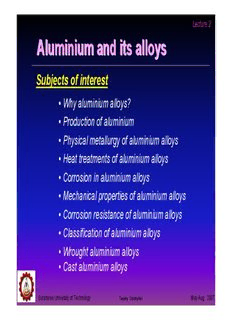
Lecture 2 aluminium and aluminium alloy PDF
Preview Lecture 2 aluminium and aluminium alloy
Lecture 2 AAlluummiinniiuumm aanndd iittss aallllooyyss Subjects of interest • Why aluminium alloys? • Production of aluminium • Physical metallurgy of aluminium alloys • Heat treatments of aluminium alloys • Corrosion in aluminium alloys • Mechanical properties of aluminium alloys • Corrosion resistance of aluminium alloys • Classification of aluminium alloys • Wrought aluminium alloys • Cast aluminium alloys Suranaree University of Technology Tapany Udomphol May-Aug 2007 OObbjjeeccttiivveess • This chapter provides fundamental knowledge of different methods of productions / heat treatments of aluminium alloys and the use of various types of cast and wrought aluminium alloys. • The influences of alloy composition, microstructure and heat treatment on chemical and mechanical properties of aluminium alloys will be discussed in relation to its applications. Suranaree University of Technology Tapany Udomphol May-Aug 2007 Introduction- Why aluminium alloys? • Abundant element of 8% on earth crust and normally found in oxide forms (Al O ), i.e., bauxite, kaolinite, nepheline and alunite. 2 3 • Found in United states, Italy, France. • Have not been found in Thailand but in Malaysia, Vietnam. Bauxite with penny Bauxite-pebbly Kaolinite http://www.galleries.com Suranaree University of Technology Tapany Udomphol May-Aug 2007 Introduction- Why aluminium alloys? www.corusgroup-koblenz.com http://ngdir.ir/minemineral Comparison of Al and steel Attractive properties • High corrosion resistance • Excellent machining properties • Light weight • High thermal/electrical conductivity • High ductility/easily deformable http://ngdir.ir/minemineral Suranaree University of Technology Tapany Udomphol May-Aug 2007 Applications for aluminium alloys Construction Containers & Equipment & Packaging Automotives Aerospace Suranaree University of Technology Tapany Udomphol May-Aug 2007 PPrroodduuccttiioonn ooff AAlluummiinniiuumm France 1855: • H. Sainte-Claire Deville first reduced aluminium chloride with sodium. Austria 1888: • Karl Josef Bayer first patented the Bayer process (digesting crushed bauxite in strong sodium hydroxide solution at temperatures upto 240oC. Germany : • Hall-Héroult introduced Hall-Héroult process by dissolving the alumina in molten cryolite (Na AlF ) 3 6 United states • Alcoa commenced a chloride-based 1976: smelting process using alumina combined with chloride. Suranaree University of Technology Tapany Udomphol May-Aug 2007 EExxttrraaccttiioonn ooff aalluummiinniiuumm Aluminium can be extracted from bauxite, Kaolinite or nepheline. 30-50% Alumina (Al O ) 2 3 3-13% Silica (SiO ) Bauxite: 2 10-18% Titanium oxide (TiO ) 2 Balanced water (H O) 2 30-32% Alumina (Al O ) Kaolinite 2 3 Balanced Silica (SiO ) and water (H O) 2 2 30% Alumina (Al O ) 2 3 Nepheline 40% Silica (SiO ) 2 20% Na O + K O 2 2 Note: extraction processes of aluminium require high electricity (cid:1) consumption. suitable for countries where cheap electricity is supplied. Suranaree University of Technology Tapany Udomphol May-Aug 2007 Bayer process Alumina (Al O ) is extracted by digesting crushed bauxite in 2 3 strong sodium hydroxide (NaOH) solution at Temp upto 240oC. First step • Most of alumina is dissolved to give sodium aluminate (NaAlO ) 2 which is soluble in water. • Insoluble residues or ‘Red mud’, mainly composed of oxide of Fe and Si, are removed by filtration. Al O .xH O + 2NaOH → 2NaAlO + (x +1)H O …Eq. 1 2 3 2 2 2 Note: Optimisation of the process with the aid of temperature and pressure, depending on the nature of bauxite ores, (to obtain different forms of alumina αααα, ββββor γγγγ). Suranaree University of Technology Tapany Udomphol May-Aug 2007 Bayer process Second step • The next step is to decompose NaAlO to give alumina (Al O ), at 2 2 3 temp ~ 50oC. • This reverse reaction is achieved by adding crystals of trihydrate Al O .3H O (seeding agent) to promote fine precipitates of this 2 3 2 compound. …Eq. 2 2NaAlO + 2H O → 2NaOH + Al O .3H O 2 2 2 3 2 • The water is then removed by calcining at high temperatures. (cid:1) At Temp ~ 400-600oC γγγγalumina (chemically active). (cid:1) At Temp ~ 1200oC ααααalumina (inert) ∆ …Eq. 3 Al O .3H O → Al O 2 3 2 2 3 Suranaree University of Technology Tapany Udomphol May-Aug 2007 Bayer process • In the case of bauxite containing high silica, alumina loss during the process is increased. • Silica reacts with NaOH at the first step to give sodium silicate Na SiO . 2 3 SiO + 2NaOH → Na SiO + H O …Eq. 4 2 2 3 2 • Sodium silicate then reacts with sodium aluminate to give nonsoluble sodium alumosilicate. 2NaAlO + 2Na SiO → Na Al Si O .2H O + 4NaOH …Eq. 5 2 2 3 2 2 2 8 2 Solution: 1) Using bauxite with high alumina, low silica. 2) Adding lime or lime stone to react with bauxite to give calcium silicate Ca SiO . 2 4 Suranaree University of Technology Tapany Udomphol May-Aug 2007
Description: